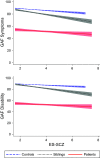Examining the association between exposome score for schizophrenia and functioning in schizophrenia, siblings, and healthy controls: Results from the EUGEI study
- PMID: 33736735
- PMCID: PMC8080213
- DOI: 10.1192/j.eurpsy.2021.19
Examining the association between exposome score for schizophrenia and functioning in schizophrenia, siblings, and healthy controls: Results from the EUGEI study
Abstract
Background: A cumulative environmental exposure score for schizophrenia (exposome score for schizophrenia [ES-SCZ]) may provide potential utility for risk stratification and outcome prediction. Here, we investigated whether ES-SCZ was associated with functioning in patients with schizophrenia spectrum disorder, unaffected siblings, and healthy controls.
Methods: This cross-sectional sample consisted of 1,261 patients, 1,282 unaffected siblings, and 1,525 healthy controls. The Global Assessment of Functioning (GAF) scale was used to assess functioning. ES-SCZ was calculated based on our previously validated method. The association between ES-SCZ and the GAF dimensions (symptom and disability) was analyzed by applying regression models in each group (patients, siblings, and controls). Additional models included polygenic risk score for schizophrenia (PRS-SCZ) as a covariate.
Results: ES-SCZ was associated with the GAF dimensions in patients (symptom: B = -1.53, p-value = 0.001; disability: B = -1.44, p-value = 0.001), siblings (symptom: B = -3.07, p-value < 0.001; disability: B = -2.52, p-value < 0.001), and healthy controls (symptom: B = -1.50, p-value < 0.001; disability: B = -1.31, p-value < 0.001). The results remained the same after adjusting for PRS-SCZ. The degree of associations of ES-SCZ with both symptom and disability dimensions were higher in unaffected siblings than in patients and controls. By analyzing an independent dataset (the Genetic Risk and Outcome of Psychosis study), we replicated the results observed in the patient group.
Conclusions: Our findings suggest that ES-SCZ shows promise for enhancing risk prediction and stratification in research practice. From a clinical perspective, ES-SCZ may aid in efforts of clinical characterization, operationalizing transdiagnostic clinical staging models, and personalizing clinical management.
Keywords: cannabis; childhood trauma; environment; functioning; psychosis.
Conflict of interest statement
Celso Arango has been a consultant to or has received honoraria or grants from Acadia, Angelini, Gedeon Richter, Janssen-Cilag, Lundbeck, Minerva, Otsuka, Roche, Sage, Servier, Shire, Schering-Plough, Sumitomo Dainippon Pharma, Sunovion, and Takeda. Michael O’Donovan is supported by a collaborative research grant from Takeda Pharmaceuticals. Maria Paz Garcia-Portilla has been a consultant to and/or has received honoraria/grants from Angelini, Alianza Otsuka-Lundbeck, Instituto de Salud Carlos III, Janssen-Cilag, Lundbeck, Otsuka, Pfizer, and Sage Therapeutics.
Figures

Similar articles
-
The Exposome Paradigm to Understand the Environmental Origins of Mental Disorders.Alpha Psychiatry. 2021 Jun 28;22(4):171-176. doi: 10.5152/alphapsychiatry.2021.21307. eCollection 2021 Jul. Alpha Psychiatry. 2021. PMID: 36424935 Free PMC article. Review.
-
Association between exposome score for schizophrenia and functioning in first-episode psychosis: results from the Athens first-episode psychosis research study.Psychol Med. 2023 Apr;53(6):2609-2618. doi: 10.1017/S0033291721004542. Epub 2021 Nov 18. Psychol Med. 2023. PMID: 34789350 Free PMC article.
-
Examining the association between exposome score for schizophrenia and cognition in schizophrenia, siblings, and healthy controls: Results from the EUGEI study.Psychiatry Res. 2023 May;323:115184. doi: 10.1016/j.psychres.2023.115184. Epub 2023 Mar 28. Psychiatry Res. 2023. PMID: 37015164
-
Examining the independent and joint effects of genomic and exposomic liabilities for schizophrenia across the psychosis spectrum.Epidemiol Psychiatr Sci. 2020 Nov 17;29:e182. doi: 10.1017/S2045796020000943. Epidemiol Psychiatr Sci. 2020. PMID: 33200977 Free PMC article.
-
Estimating Aggregate Environmental Risk Score in Psychiatry: The Exposome Score for Schizophrenia.Front Psychiatry. 2021 May 28;12:671334. doi: 10.3389/fpsyt.2021.671334. eCollection 2021. Front Psychiatry. 2021. PMID: 34122186 Free PMC article. Review.
Cited by
-
The Exposome Paradigm to Understand the Environmental Origins of Mental Disorders.Alpha Psychiatry. 2021 Jun 28;22(4):171-176. doi: 10.5152/alphapsychiatry.2021.21307. eCollection 2021 Jul. Alpha Psychiatry. 2021. PMID: 36424935 Free PMC article. Review.
-
Global research trends on the human exposome: a bibliometric analysis (2005-2024).Environ Sci Pollut Res Int. 2025 Mar;32(13):7808-7833. doi: 10.1007/s11356-025-36197-7. Epub 2025 Mar 8. Environ Sci Pollut Res Int. 2025. PMID: 40056347 Free PMC article. Review.
-
Estimating the Association Between Exposome and Psychosis as Well as General Psychopathology: Results From the ABCD Study.Biol Psychiatry Glob Open Sci. 2022 Jun 1;2(3):283-291. doi: 10.1016/j.bpsgos.2022.05.005. eCollection 2022 Jul. Biol Psychiatry Glob Open Sci. 2022. PMID: 36325038 Free PMC article.
-
Schizophrenia: A Narrative Review of Etiopathogenetic, Diagnostic and Treatment Aspects.J Clin Med. 2022 Aug 27;11(17):5040. doi: 10.3390/jcm11175040. J Clin Med. 2022. PMID: 36078967 Free PMC article.
-
Editorial: New trends in psychiatric research: Toward the clinical characterization of the individual case and the personalization of treatments.Front Psychiatry. 2022 Oct 6;13:1042536. doi: 10.3389/fpsyt.2022.1042536. eCollection 2022. Front Psychiatry. 2022. PMID: 36276333 Free PMC article. No abstract available.
References
-
- Zwicker A, Denovan-Wright EM, Uher R. Gene–environment interplay in the etiology of psychosis. Psychol Med. 2018;48:1925–36. - PubMed
Publication types
MeSH terms
Grants and funding
LinkOut - more resources
Full Text Sources
Other Literature Sources
Medical

